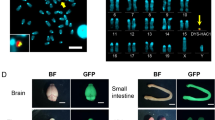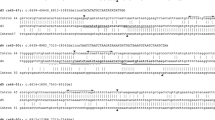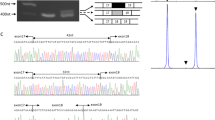Abstract
The recent discovery of sequences at the site of the Duchenne muscular dystrophy (DMD) gene in humans1,2 has opened up the possibility of a detailed molecular analysis of the genes in humans and in related mammalian species. Until relatively recently, there was no obvious mouse model of this genetic disease for the development of therapeutic strategies. The identification of a mouse X-linked mutant showing muscular dystrophy3, mdc, has provided a candidate mouse genetic homologue to the DMD locus; the relatively mild pathological features of mdx suggest it may have more in common with mutations of the Becker muscular dystrophy type1 at the same human locus, however. But the close genetic linkage of mdx to G6PD and Hprt on the mouse X chromosome4–6, coupled with its comparatively mild pathology, have suggested that the mdx mutation may instead correspond to Emery Dreifuss muscular dystrophy which itself is closely linked to DNA markers at Xq28-qter in the region of G6PD on the human X chromosome7. Using an interspecific mouse domesticus/spretus cross8, segregating for a variety of markers on the mouse X chromosome, we have positioned on the mouse X chromosome sequences homologous to a DMD cDNA clone. These sequences map provocatively close to the mdx mutation and unexpectedly distant from sparse fur, spf, the mouse homologue of OTC (ornithine transcarbamylase) which is closely linked to DMD on the human X chromosome9.
This is a preview of subscription content, access via your institution
Access options
Subscribe to this journal
Receive 51 print issues and online access
$199.00 per year
only $3.90 per issue
Buy this article
- Purchase on Springer Link
- Instant access to full article PDF
Prices may be subject to local taxes which are calculated during checkout
Similar content being viewed by others
References
1. Monaco, A. P. & Kunkel, L, M. Trends Genet. 3, 33–37 (1987). 2. Smith, T J. et al. Nucleic Acids Res. 15, 2167–2174 (1987). 3. Bulfield, G., Siller, W. G., Wight, P. A. L. & Moore, K. J. Proc. natn. Acad. Sci. U.S.A. 81, 1189–1192 (1984). 4. Chapman, V. M., Murawski, M., Miller, D. & Swiatek, D. Mouse News Lett. 72, 120 (1985). 5. Bulfield, G. & Isaacson, J. H. Mouse News Lett. 72, 97 (1985). 6. Peters, J. & Ball, S. T. Mouse News Lett. 72, 17–18 (1985). 7. Hodgson, S. et al. Hum. Genet. 74, 409–416 (1986). 8. Brown, S. D. M. Trends Genet. 1, 219–220 (1985). 9. Davies, K. E. et al. Nucleic Acids Res. 13, 3419–3426 (1985). 10. Fisher, E. M. C, Cavanna, J. S. & Brown, S. D. M. Proc. natn. Acad. Sci. U.S.A. 82, 5846–5849 (1985). 11. Avner, P., Amar, L., Arnaud, D., Hanauer, A. & Cambron, J. Proc. natn. Acad. Sci. U.S.A. (in the press). 12. Buckle, V. J. et al. Clin. Genet. 25, 275–285 (1984). 13. Buckle, V. J. et al. Human Gene Mapping 8, 594–595 (1985). 14. Grosschedl, R., Weaver, D., Baltimore, D. & Constantini, F. Cell 38, 647–658 (1984). 15. Feinberg, A. P. & Vogelstein, B. Analyt. Biochem. 137, 266–267 (1984).
Author information
Authors and Affiliations
Rights and permissions
About this article
Cite this article
Brockdorff, N., Cross, G., Cavanna, J. et al. The mapping of a cDNA from the human X-linked Duchenne muscular dystrophy gene to the mouse X chromosome. Nature 328, 166–168 (1987). https://doi.org/10.1038/328166a0
Received:
Accepted:
Issue Date:
DOI: https://doi.org/10.1038/328166a0
This article is cited by
-
Temporal changes in magnetic resonance imaging in the mdx mouse
BMC Research Notes (2013)
-
Anchored reference loci for comparative genome mapping in mammals
Nature Genetics (1993)
-
Time course study of the isometric contractile properties of mdx mouse striated muscles
Journal of Muscle Research and Cell Motility (1993)
-
Mouse X Chromosome
Mammalian Genome (1992)
-
Sequence analysis of two exons from the murine dystrophin locus
Mammalian Genome (1991)
Comments
By submitting a comment you agree to abide by our Terms and Community Guidelines. If you find something abusive or that does not comply with our terms or guidelines please flag it as inappropriate.



